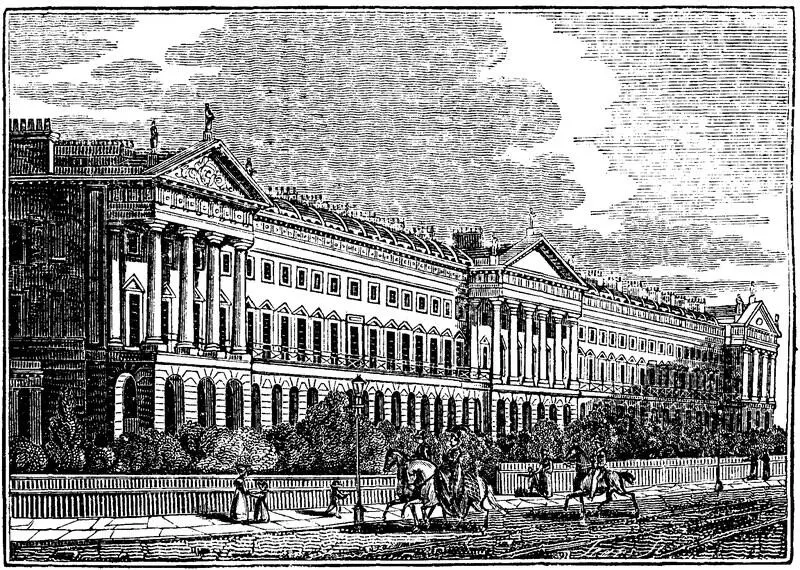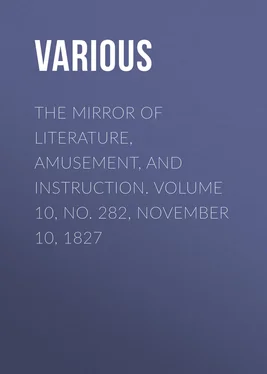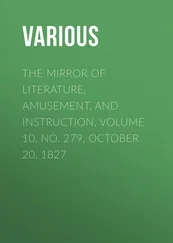Various - The Mirror of Literature, Amusement, and Instruction. Volume 10, No. 282, November 10, 1827
Здесь есть возможность читать онлайн «Various - The Mirror of Literature, Amusement, and Instruction. Volume 10, No. 282, November 10, 1827» — ознакомительный отрывок электронной книги совершенно бесплатно, а после прочтения отрывка купить полную версию. В некоторых случаях можно слушать аудио, скачать через торрент в формате fb2 и присутствует краткое содержание. Жанр: foreign_antique, periodic, Развлечения, foreign_edu, на английском языке. Описание произведения, (предисловие) а так же отзывы посетителей доступны на портале библиотеки ЛибКат.
- Название:The Mirror of Literature, Amusement, and Instruction. Volume 10, No. 282, November 10, 1827
- Автор:
- Жанр:
- Год:неизвестен
- ISBN:нет данных
- Рейтинг книги:4 / 5. Голосов: 1
-
Избранное:Добавить в избранное
- Отзывы:
-
Ваша оценка:
- 80
- 1
- 2
- 3
- 4
- 5
The Mirror of Literature, Amusement, and Instruction. Volume 10, No. 282, November 10, 1827: краткое содержание, описание и аннотация
Предлагаем к чтению аннотацию, описание, краткое содержание или предисловие (зависит от того, что написал сам автор книги «The Mirror of Literature, Amusement, and Instruction. Volume 10, No. 282, November 10, 1827»). Если вы не нашли необходимую информацию о книге — напишите в комментариях, мы постараемся отыскать её.
The Mirror of Literature, Amusement, and Instruction. Volume 10, No. 282, November 10, 1827 — читать онлайн ознакомительный отрывок
Ниже представлен текст книги, разбитый по страницам. Система сохранения места последней прочитанной страницы, позволяет с удобством читать онлайн бесплатно книгу «The Mirror of Literature, Amusement, and Instruction. Volume 10, No. 282, November 10, 1827», без необходимости каждый раз заново искать на чём Вы остановились. Поставьте закладку, и сможете в любой момент перейти на страницу, на которой закончили чтение.
Интервал:
Закладка:
Various
The Mirror of Literature, Amusement, and Instruction / Volume 10, No. 282, November 10, 1827
Architectural Illustrations
No. III.
HANOVER TERRACE, REGENT'S PARK

"The architectural spirit which has arisen in London since the late peace, and ramified from thence to every city and town of the empire, will present an era in our domestic history." Such is the opinion of an intelligent writer in a recent number of Brande's "Quarterly Journal;" and he goes on to describe the new erections in the Regent's Park as the "dawning of a new and better taste, and in comparison with that which preceded it, a just subject of national exultation;" in illustration of which fact we have selected the subjoined view of Hanover Terrace , being the last group on the left of the York-gate entrance, and that next beyond Sussex-place, distinguishable by its cupola tops.
Hanover Terrace, unlike Cornwall and other terraces of the Regent's Park, is somewhat raised from the level of the road, and fronted by a shrubbery, through which is a carriage-drive. The general effect of the terrace is pleasing; and the pediments, supported on an arched rustic basement by fluted Doric columns, are full of richness and chaste design; the centre representing an emblematical group of the arts and sciences, the two ends being occupied with antique devices; and the three surmounted with figures of the Muses. The frieze is also light and simply elegant. The architect is Mr. Nash, to whose classic taste the Regent's Park is likewise indebted for other interesting architectural groups.
Altogether, Hanover Terrace may be considered as one of the most splendid works of the neighbourhood, and it is alike characteristic of British opulence, and of the progressive improvement of national taste. On the general merits of these erections we shall avail ourselves of the author already quoted, inasmuch as his remarks are uniformly distinguished by moderation and good taste.
"Regent's Park, and its circumjacent buildings, promise, in few years, to afford something like an equipoise to the boasted Palace-group of Paris. If the plan already acted upon is steadily pursued, it will present a union of rural and architectural beauty on a scale of greater magnificence than can be found in any other place. The variety is here in the detached groups, and not as formerly in the individual dwellings, by which all unity and grandeur of effect was, of course, annihilated. These groups, undoubtedly, will not always bear the eye of a severe critic, but altogether they exhibit, perhaps, as much beauty as can easily be introduced into a collection of dwelling-houses of moderate size. Great care has been, taken to give something of a classical air to every composition; and with this object, the deformity of door-cases has been in most cases excluded, and the entrances made from behind. The Doric and Ionic orders have been chiefly employed; but the Corinthian, and even the Tuscan, are occasionally introduced. One of these groups is finished with domes; but this is an attempt at magnificence which, on so small a scale, is not deserving of imitation."
THE ISLE OF SHEPPEY
SIR,—Under the Arcana of Science , in your last Number, I observed an account of the inroads made by the sea on the Isle of Sheppey, together with the exhumation there of numerous animal and vegetable remains. As an additional fact I inform you, that, at about three hundred feet below the surface of the sand-bank, (of which the island is composed,) there is a vast prostrate antediluvian forest, masses of which are being continually developed by the influence of marine agency, and exhibit highly singular appearances. When the workmen were employed some years back in sinking a well to supply the garrison with water, the aid of gunpowder was required to blast the fossil timber, it having attained, by elementary action and the repose of ages, the hard compactness of rock or granite stone. Aquatic productions also appear to observation in their natural shape and proportion, with the advantage of high preservation, to facilitate the study of the inquiring philosopher. I have seen entire lobsters, eels, crabs, &c. all transformed into perfect lapidifications. Many of these interesting bodies have been selected, and at the present time tend to enrich the elaborate collections of the Museum of London and the Institute of France. During the winter of 1825, in examining a piece of petrified wood, which I had picked up on the shore, we discovered a very minute aperture, barely the size of a pin-hole, and on breaking the substance by means of a large hammer, to our surprise and regret we crushed a small reptile that was concealed inside, and which, in consequence, we were unfortunately prevented from restoring to its original shape. The body was of a circular shape and iron coloured; but from the blood which slightly moistened the face of the instrument, we were satisfied it must have been animated. I showed the fragments of both to a gentleman in the island, who, like myself, lamented the accident, as it had, in all likelihood, deprived science of forming some valuable (perhaps) deductions on this incarcerated, or (if I may be allowed the expression) compound phenomenon. I have merely related the above incident in order to show the possibility of there being other creatures accessible to discovery under similar circumstances, and in their nature, perhaps homogeneous. I left the island next day, and therefore had no further opportunities of confirming such an opinion; but the place itself abounds with substances which would authorize such conjectures.
D. A. P. 1 1 We thank our correspondent for the above communication on one of the most interesting phenomena of British geology; for, as we hinted in our last, the pleasantest hours of our sojourn at Margate, about three years since, were passed in the watchmaker's museum, nearly opposite the Marine Library, which collection contains many Sheppey fossils, especially a prawn , said to be the only one in England. We remember the proprietor to have been a self-educated man: he had been to the museum at Paris twice or thrice, and spoke in high terms of the courteous reception he met with from M Cuvier; and we are happy to corroborate his representations. With respect to the reptile , or, as we should say, insect , alluded to in the preceding letter, we suppose it to have been a vermicular insect, similar to those inhabiting the cells of corallines , of whose tiny labours, in the formation of coral islands, we quoted a spirited poetical description in No. 279 of the MIRROR. Corallines much resemble fossil or petrified wood; and we recollect to have received from the landlady of an inn at Portsmouth a small branch of fossil wood , which she asserted to be coral , and that upon the authority of scores of her visiters; but the fibres, &c. of the wood were too evident to admit of a dispute.
ANTICIPATED FRENCH MILLENNIUM, OR THE PARISIAN "TRIVIA."
"Travellers of that rare tribe, Who've seen the countries they describe."
HANNAH MORE.When daudling diligences drag
Their lumbering length along 2 2 "Which, like a wounded snake, drags its slow length along"—POPE.
no more—
That odd anomaly!—or wag
Gon call'd, or coach—a misnomer 3 3 It is, indeed, difficult to avoid one, call it what you will, and quite as difficult to find a more absurd name than that adopted, unless, indeed, (why the machine goes but five miles an hour,) it is called a diligence from not being diligent, as the speaker of our House of Commons may be so designated from not speaking. It consists of three bodies, carries eighteen inside, and is not unfrequently drawn by nine horses. A cavalry charge, therefore, could scarcely make more noise. Hence, and from the other circumstance, its association in the second stanza with the triune sonorous Cerberus. A diligence indeed!
—
Интервал:
Закладка:
Похожие книги на «The Mirror of Literature, Amusement, and Instruction. Volume 10, No. 282, November 10, 1827»
Представляем Вашему вниманию похожие книги на «The Mirror of Literature, Amusement, and Instruction. Volume 10, No. 282, November 10, 1827» списком для выбора. Мы отобрали схожую по названию и смыслу литературу в надежде предоставить читателям больше вариантов отыскать новые, интересные, ещё непрочитанные произведения.
Обсуждение, отзывы о книге «The Mirror of Literature, Amusement, and Instruction. Volume 10, No. 282, November 10, 1827» и просто собственные мнения читателей. Оставьте ваши комментарии, напишите, что Вы думаете о произведении, его смысле или главных героях. Укажите что конкретно понравилось, а что нет, и почему Вы так считаете.












